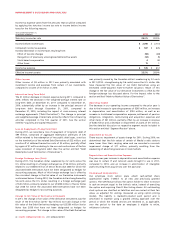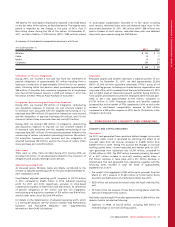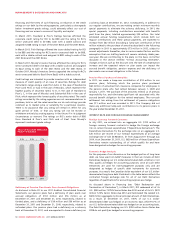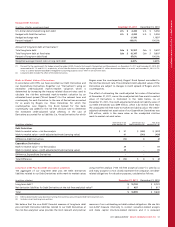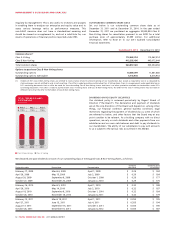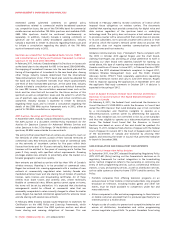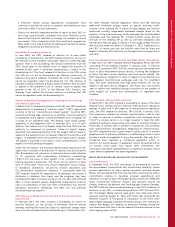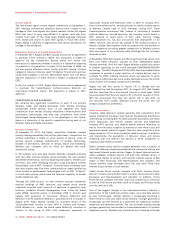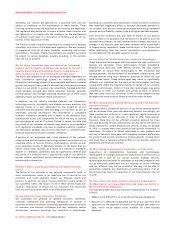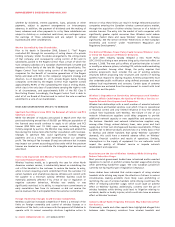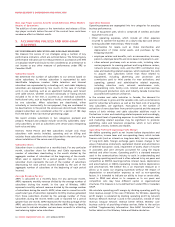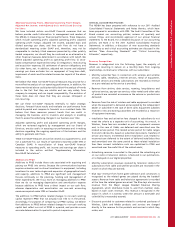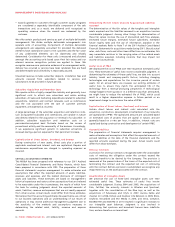Rogers 2011 Annual Report Download - page 60
Download and view the complete annual report
Please find page 60 of the 2011 Rogers annual report below. You can navigate through the pages in the report by either clicking on the pages listed below, or by using the keyword search tool below to find specific information within the annual report.MANAGEMENT’S DISCUSSION AND ANALYSIS
interested parties submitted comments on general policy
considerations related to commercial mobile broadband spectrum
use, competition issues, the use of the 700 MHz band for commercial
mobile services and whether 700 MHz spectrum and available 2500-
2690 MHz spectrum should be auctioned simultaneously or
separately. In addition, Industry Canada is seeking comments on
spectrum use for public safety broadband applications. Industry
Canada is expected to render its decisions regarding these issues and
to initiate a consultation regarding the details of the 700 MHz
auction framework early in 2012.
Decisions on a Band Plan for Broadband Radio Service (“BRS”)
and Consultation on a Policy and Technical Framework to License
Spectrum in the Band 2500-2690 MHz
In February 2011, Industry Canada released its Decisions on issues such
as the band plan to be adopted for BRS in the band 2500-2690 MHz,
the mapping of incumbent licencees into the new band plan and the
timing of the migration of incumbents to the new band plan. Among
other things, Industry Canada determined that the International
Telecommunications Union (“ITU”) band plan would be adopted for
the band and that incumbent licensees must return approximately
one-third of their licensed BRS spectrum. At the same time, Industry
Canada initiated a consultation on a policy and technical framework
for new BRS licences. The consultation examined issues such as the
block and tier sizes that will be used for the future auction of this
spectrum as well as competition issues and the extent to which the
use of spectrum caps, spectrum set-asides and rollout conditions are
warranted. Industry Canada is expected to render its decisions
regarding these issues and to initiate a consultation regarding the
details of the 2500 MHz auction framework early in 2012, either as
part of its 700 MHz consultation or separately.
AWS Auction, Roaming and Tower/Site Policy
In November 2007, Industry Canada released its policy framework for
the AWS auction in a document entitled Policy Framework for the
Auction for Spectrum Licences for Advanced Wireless Services and
other Spectrum in the 2 GHz Range. Of the 90 MHz of available AWS
spectrum, 40 MHz were set aside for new entrants.
The policy further prescribed that all carriers are allowed to roam on
the networks of other carriers outside of their licenced territories at
commercial rates. New entrants are able to roam at commercial rates
on the networks of incumbent carriers for five years within their
licenced territories and for 10 years nationally. National new entrant
licencees will be entitled to five years of roaming and a further five
years if they comply with specified rollout requirements. Roaming
privileges enable new entrants to potentially enter the market on a
broader geographic scale more quickly.
New entrants are defined as carriers with less than 10% of Canada’s
wireless revenue. Roaming is to be provided at commercial rates.
Rogers has entered into roaming agreements with a number of new
entrants at commercially negotiated rates. Industry Canada also
mandated antenna tower and site sharing for all holders of spectrum
licences, radio licences and broadcasting certificates. All of these
entities must share towers and antenna sites, where technically
feasible at commercial rates. Where parties cannot agree on terms,
the terms will be set by arbitration. It is expected that site-sharing
arrangements would be offered at commercial rates that are
reasonably comparable to rates currently charged to others for similar
access. Rogers has reached commercial agreements for antenna tower
and site sharing with several new entrants.
In February 2008, Industry Canada issued Responses to Questions for
Clarification on the AWS Policy and Licencing Frameworks, which
answered questions about the AWS spectrum auction and about
tower sharing and roaming obligations of licencees. This was
followed in February 2008 by revised conditions of licence which
imposed those obligations on wireless carriers. The documents
clarified that roaming must provide connectivity for digital voice and
data services regardless of the spectrum band or underlying
technology used. The policy does not require a host network carrier
to provide a roamer with a service which that carrier does not provide
to its own subscribers, nor to provide a roamer with a service, or level
of service, which the roamer’s network carrier does not provide. The
policy also does not require seamless communications hand-off
between home and host networks.
Globalive Communications Corp. (“Globalive”) filed a complaint with
the CRTC in October 2010 against Rogers and the chatr brand,
claiming that Rogers was providing an undue preference to itself in
providing our chatr brand with seamless handoff for roaming. As
noted above, this type of roaming was not mandated in the Industry
Canada conditions of licence. In June 2011, in Telecom Decision CRTC
2011-360, the CRTC dismissed Globalive’s complaint. In August 2011,
Globalive Wireless Management Corp. and The Public Interest
Advocacy Centre (“PIAC”) filed, separately, applications requesting
that the Commission review and vary its June 2011 Decision. Rogers
filed its response opposing the applications in September 2011 and
the applicants filed reply comments in October 2011. A decision is
expected in the spring of 2012.
Court of Appeal Overturns Federal Court Decision and Restores
Governor in Council Decision That Ruled Globalive Eligible to
Operate in Canada
On February 4, 2011, the Federal Court overturned the Governor in
Council Decision P.C 2009-2008 in which the Governor in Council had
varied the CRTC Decision that ruled Globalive was in fact controlled
by a non-Canadian and therefore ineligible to operate as a
telecommunications common carrier by determining the opposite,
that is, that Globalive was not controlled in fact by a non-Canadian
and thus was eligible to operate as a telecommunications common
carrier. The Federal Court found that the Governor in Council
Decision was based on errors of law and should be quashed. On
February 17, 2011, Globalive filed a Notice of Appeal with the Federal
Court of Appeal. On June 8, 2011, the Court of Appeal ruled in favour
of the Government of Canada and Globalive by allowing their
appeals and restoring the Order in Council that permitted Globalive
to launch in December 2009.
CABLE REGULATION AND REGULATORY DEVELOPMENTS
CRTC Vertical Integration Policy Decision
In September 2011, the CRTC released Broadcasting Regulatory Policy
CRTC 2011-601 (Policy) setting out the Commission’s decisions on its
regulatory framework for vertical integration in the broadcasting
sector. Vertical integration refers to the ownership or control by one
entity of both programming services, such as conventional television
stations, or pay and specialty services, as well as distribution services,
such as cable systems or direct-to-home (“DTH”) satellite services. The
Policy:
• Prohibits companies from offering television programs on an
exclusive basis to their mobile or Internet subscribers. Any program
broadcast on television, including hockey games and other live
events, must be made available to competitors under fair and
reasonable terms.
• Allows companies to offer exclusive programming to their Internet
or mobile customers provided that it is produced specifically for an
Internet portal or a mobile device.
• Adopts a code of conduct to prevent anti-competitive behavior and
ensure all distributors, broadcasters and online programming
services negotiate in good faith. To protect Canadians from losing
56 ROGERS COMMUNICATIONS INC. 2011 ANNUAL REPORT


